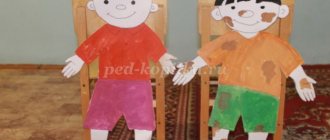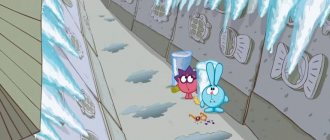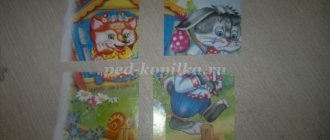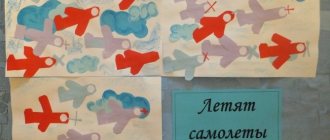MAGAZINE Preschooler.RF
Notes on communication (speech development) in the second junior group Topic: “Visiting Mishka” Examination of tea utensils Program content: Continue to introduce children to objects in their immediate environment - tea utensils and their purpose. Expand children's vocabulary through nouns (tea party, sugar bowl, napkin bowl), adjectives (tea, red, blue, yellow, green), details, qualities and properties. Teach children to answer the teacher’s questions by matching the words in a sentence. C Foster a caring attitude towards household items Integration of educational areas: communication, cognition, socialization, work, health, safety. Preliminary work: • Games in the doll corner • Examination of dishes in everyday life • Reading the work of K.I. Chukovsky “Fedorino Grief” Material: • Table • Tablecloth • Chairs for guests BearsContents of educational activities
1. Organizational moment Children sit in a semicircle in front of the table. There is a knock on the door. Educator: Children, who is knocking on our door, but won’t dare to enter? I'll go and have a look, and then I'll tell you all. Children, who is this? (shows Mishka) Look how handsome he is today. Bear, is it your holiday today? - Yes, guests will come to me. Please help me set the table, I want to treat them to tea. Guys, can we help our Mishka? 2. Main part: Didactic game: “What’s extra?” The teacher begins to set the table. Places on the table: cups, frying pan, saucepan. Children: -No. The pot and pan are superfluous. Educator: -Why is there no need for a saucepan on the table? Children: -They cook soup in it. Educator: -Why is there an extra frying pan? Children: - Meat, fish and cutlets are fried in it. Educator: - Children, please help me set the table for tea. 3 Game situation “Let’s set the table for tea” Children bring napkins, sugar, spoons. Educator: - where do we put the sugar? Children: - into the sugar bowl. Educator: - Correct. Special utensils for sugar - sugar bowl. And there is a special stand for napkins. I wonder who knows what it's called? (Napkin holder.) - Guys, cups, teapot, saucers, sugar bowl - all this is tea utensils - What is the saucer for? -Put a cup on it so as not to stain the tablecloth and put a spoon. Let's play with you. 4. Physical education lesson: One, two, three, four, We washed the dishes: Kettle, cup, ladle, spoon And a large ladle. This is how we helped mom! Educator: - Well done. Oh, what are we going to brew tea in? (in the kettle.) Educator: - That’s right, our kettle has boiled, only it’s hot. How are we going to drink it? What needs to be done to make the tea cool? (Blow on him.) 5. Breathing exercises Teacher: - okay, now we will blow (the teacher shows, the children do: sit up straight, bring the cup to your mouth, inhale through your nose, hold your breath, exhale through your mouth). . What are we going to treat Mishka to? (with tea) Yes, and that’s why they set the table with tea dishes. Name what dishes you put on the table? (pronounce utensils)
6 Listen to the poem: We have teaware on the table. Here is a large and yellow teapot, Very important as a boss. Here are the green cups, very fragile poor things. Here are the green saucers, only knocking will break. Here are the little white spoons, the head on a thin stem. Here is a plastic tray. He brought tea dishes!
Educator: - Well, we drank tea, how many dirty dishes are left! Where do we take it? Let's clean it up and wash it. 7. Summary “What did you learn?” What did we guys do in class? What new words did you learn? The bear treats children to candy and gives them coloring books.
| Next > |
Communication activities. Lesson notes for the second junior group
Municipal budgetary preschool educational institution "Kindergarten No. 97 "Semitsvetik" of a general developmental type with priority implementation of activities on the cognitive and speech development of children" in the city of Cheboksary, Chuvash Republic
Summary of OOD on speech development in the second group of early age
Didactic exercise “Don’t leave us, pussy!”
Reading the poem “Cat” by G. Sapgir.
Educator: Alexandrova Lyudmila Nikolaevna
Cheboksary - 2020
Software tasks:
Develop children's skills to play with and talk to toys in different ways. Develop the ability to communicate and curiosity. Train children in correct onomatopoeia, repeat after the teacher and come up with simple calls to the toy on their own. Foster love for animals and take care of them. Cultivate children's interest in listening to literary works. Introduce children to G. Sapgir’s poem “Cat”.
Materials and equipment:
toy cat, basket, scarf, bowl.
OOD progress:
1. Introductory part.
Educator:
Guys, today is such a wonderful sunny morning. Let's say hello to each other.
Greeting “Hello palms!”
Hello our hands, clap, clap, clap
Hello our legs, top, top, top,
Hello our cheeks, plop-plop-plop.
Hello my little nose, pim-pim-pim
Hello babies, hello everyone!
Educator:
Can't you hear anything? What is this strange sound? It seems to me that this strange sound is behind the door.
The teacher brings in a basket with a cat covered with a scarf, looks into the basket and asks the children a riddle.
Educator:
Guys, guess who is sitting here?
Shaggy, mustachioed,
Drinks milk
"Meow meow!" - sings.
Who is this?
Children
: Cat!
Educator:
Well done guys, that's right, it's a cat. Here she is!
The teacher takes the cat out of the basket
And the muzzle is mustachioed and the fur coat is shaggy.
What else is she like? Lets children touch, stroke and speak.
Well done!
2. Main part.
Didactic exercise “Don’t leave us, pussy!”
Educator:
Kitty, why are you so sad?
Guys, the cat told me that she was offended that they forgot to feed her, give her milk and don’t play with her. The cat wants to go to another group. What should we do so that the cat stays with us?
Children's answers.
Children
: Kitty, we love you….
Children
: Pussy, you are so beautiful...
Children
: Pussy, you have such a fluffy tail...
Children
: Pussy, you have such beautiful green eyes...
Children
: Pussy, you have such good ears...
Children
: Don't leave us, kitty
Educator:
Kitty, the guys love you very much... Guys, she is so joyful that you loved her so much and took such care of her. Well done boys. Our cat wanted to sleep. And while the pussy is sleeping, I will tell you the poem “Cat” Cat, what is your name? - Meow Are you guarding the mouse here? - Meow Meow, would you like some milk? - Meow And a puppy as a companion? - Frr - Children, what is the name of the cat in the poem? (Meow) - How does a cat answer questions? (Meow) This turns out to be how cats talk!
Then the children portray the cat (answer questions; meow and snort
) Guys, our cat has woken up!
Physical school
Our cat woke up, gracefully stretched up, bent down beautifully, twirled left and right, and smiled at the guys!
Educator:
Guys, the cat is smiling at you.
What does a cat like to eat? What will we feed her? ( Children’s answers, the teacher pours milk into a bowl)
Articulation gymnastics “The cat laps the milk.”
The kitten loves milk: If you pour it, there won’t be a drop. Lapping quickly and easily, sticking out his tongue with a “spatula”.
(open your mouth wide, make 4-5 movements with your wide tongue, as if lapping milk, then close your mouth, remove the tongue)
Educator:
Kiska, we love you so much that the guys and I want to sing you a song.
Song "Cat".
( the teacher plays a song, the children sing along)
3.Reflection (final part)
Educator:
Well, pussy, did you like our song? Cat: Meow, meow. - Guys, did you hear that the cat liked the song? Will you stay with us, pussy? - Meow. - The kitty will stay in our group and play with us.




